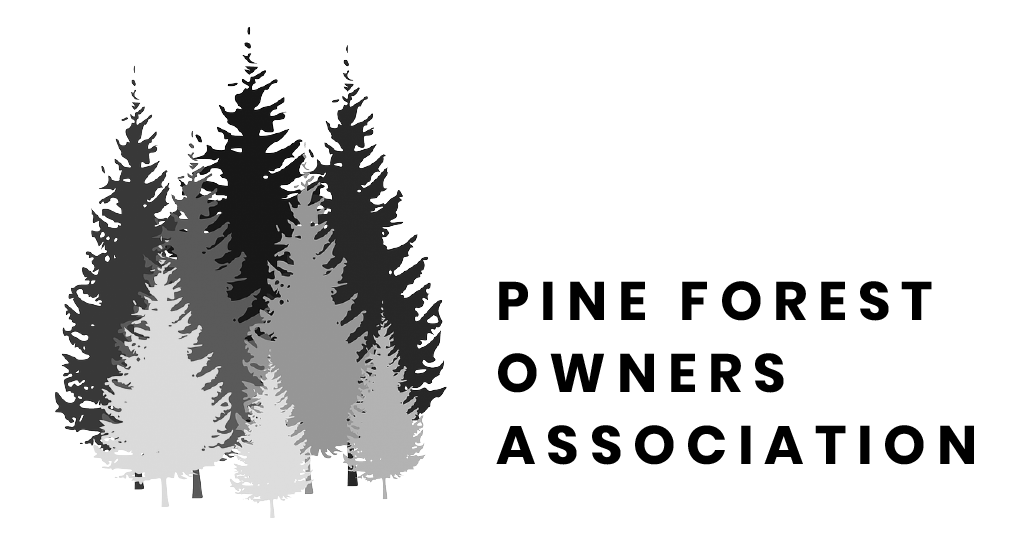Forest stewardship
History of the Pine Forest Stewardship Program
1994
After devastating, massive wildfires in Chelan, Leavenworth, Entiat, representatives of U.S. Forest Service and WA. Department of Natural Resources (DNR) hold post-fire meetings in the Methow Valley to educate residents on potential for disastrous wildfires here.
1995
Forest Service, DNR, local fire districts, Red Cross and other emergency agencies from Washington and British Columbia stage a Wildfire Simulation in Pine Forest (with approval of PF Board). Results:
PF’s forests are overstocked with trees by seven to eight times the number that are desirable to avoid devastating wildfire and to maintain forest health.
PF would be difficult to protect in an emergency because of narrow, steep roads and only one access/egress route. Emergency agencies will only send crews to areas they deem safe.
PF road names were confusing (names changed); need for clear road signs (implemented); need for standpipes (implemented).
Recommendation to hire a consulting forester and prepare a forest stewardship plan to thin PF’s trees and reduce ground fuels.
1996-1997
PF was awarded a grant by DNR to hire consulting forester Arne Arneson to prepare a Forest Stewardship Plan that focused on projects to be implemented in phases. Pine Forest Homeowners’ Association and Board approved the Forest Stewardship Plan.
1998-2007
Pine Forest received approximately $210,000 in grants from DNR, Forest Service and Bureau of Land Management to implement the Forest Stewardship Plan. In 2005 PF was honored by Forest Service and BLM for its continuing wildfire protection efforts and as an example for other communities in the Methow Valley.
Early phases focused on fuels treatment funded by the sale of marketable timber and by state and federal grant monies. Later phases were funded by the federal grants, which required 20–to-50- percent matches by PF. Thinning of trees and brush and hand-piling and burning projects were initially in PF greenbelts and later on private properties (with the approval of individual property owners). Grants also funded the preparation of a Pine Forest Community Wildfire Protection Plan; defensible space assessments of all houses in PF in 2006; and purchase of a water pumper, hoses and other fire fighting equipment.
2007-present
After the grants ended, the PF Board established a Forest Stewardship fund to continue to maintain forest health and safety by thinning trees and reducing ground fuels in greenbelts. In addition, many property owners have thinned trees and vegetation on their lots at their own expense.
Present to future actions that are needed to maintain past fuels treatment work to continue to improve the condition and health of PF forests, and protect residents and homes:
Address emergency procedures in case of a wildfire:
Install an early warning system such as a siren. Establish an emergency phone tree and other communication.
Coordinate with local fire agencies (Fire District #6, Forest Service and DNR) to develop an emergency circulation plan for residents to evacuate and fire agencies to access PF to protect homes and lives.
A wildfire emergency egress route was approved by Sun Mountain and Haub Brothers around their fields below the northeast end of Pine Forest. This route is only to be used in a wildfire emergency with the understanding that emergency vehicles might be using the same route to access Pine Forest.
Implement the Pine Forest Stewardship Management Plan prepared by consulting forester Richard Schellhaas and approved by WA DNR in January 2014. The plan focuses on detailed assessment of trees in the greenbelts; long-range recommendations for greenbelts, and general recommendations for private property owners. Prior to preparation of the plan (in April, 2013), WA DNR approved a Forest Landowners’ Cost-Sharing Application to prepare the Forest Stewardship Plan, so that Pine Forest would be reimbursed on a 50/50 cost-sharing basis.: $1,400 of the $2,800 cost of plan preparation.
Pine Forest has submitted a Forest Landowners’ Cost-Sharing Application for 2014 in order to implement fuels treatment projects, such as brush control, non-commercial thinning, pruning, prescribed burns, slash disposal. If approved, PF will be eligible for funds on a 50/50 cost-sharing basis under the program to implement projects. Property owners may be reimbursed at 50/50 cost sharing for projects they implement that are consistent with the Plan and DNR requirements.
Property owners and the Association should continue to prune and thin to eliminate dense ground fuels and ladder fuels (vegetation that could carry fire from the ground to the canopy and crown of trees).
PF Board and Homeowners’ Association should continue to dedicate funds for forest stewardship.
Property owners should maintain defensible spaces around their homes and keep plant materials in healthy condition.
Pests & Diseases
We’ve collected information sheets on specific diseases and pests that can affect our forest. If you suspect something is wrong with a tree, the links on this page might help you identify the problem.
Weeds
Being a good steward of the land includes knowing a noxious weed when you see one. The Methow Conservancy has a good guide to help you recognize and control them. Weed Guide
Plant Lists
Washington Native Plant Society: Bluejay, Meadowlark and Woodpecker trails
What’s in bloom in May?
Compiled and researched by community members Jan Sodt and Kim Des Rochers in memory of Mary Kiesau, who shared her love and knowledge of the natural world with many of us in Pine Forest and the Methow Valley.




